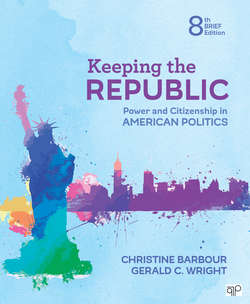Читать книгу Keeping the Republic - Christine Barbour - Страница 79
На сайте Литреса книга снята с продажи.
North and South
ОглавлениеThe compromise reconciling the large and small states was not the only one the delegates crafted. The northern and southern states, which is to say the non-slave-owning and the slave-owning states, were at odds over how population was to be determined for purposes of representation in the lower house of Congress. The southern states wanted to count slaves as part of their population when determining how many representatives they got, even though they had no intention of letting the slaves vote. Including slaves would give them more representatives and thus more power in the House of Representatives. For exactly that reason, the northern states said that if slaves could not vote, they should not be counted. The bizarre compromise, also a triumph of politics if not humanity, is known as the Three-fifths Compromise. It was based on a formula developed by the Confederation Congress in 1763 to allocate tax assessments among the states. According to this compromise, for representation purposes, each slave would count as three-fifths of a person—that is, every five slaves would count as three people. Interestingly, the actual language in the Constitution is a good deal cagier than this. It says that representatives and taxes shall be determined according to population, figured “by adding to the whole Number of free Persons, including those bound to Service for a Term of Years, and excluding Indians not taxed, three fifths of all other Persons.”
Three-fifths Compromise the formula for counting five slaves as three people for purposes of representation, which reconciled northern and southern factions at the Constitutional Convention
The issue of slavery was divisive enough for the early Americans that the most politically safe approach was not to mention it explicitly at all and thus to avoid having to endorse or condemn it. Implicitly, of course, the silence had the effect of letting slavery continue. Article I, Section 9, of the Constitution, in similarly vague language, allows that
The Migration or Importation of such Persons as any of the States now existing shall think proper to admit, shall not be prohibited by Congress prior to the Year one thousand eight hundred and eight, but a Tax or duty may be imposed on such Importation, not exceeding ten dollars for each Person.
Even more damning, Article IV, Section 2, obliquely provides for the return of runaway slaves:
No Person held to Service or Labour in one State under the Laws thereof, escaping into another, shall, in Consequence of any Law or Regulation therein, be discharged from such Service or Labour, but shall be delivered up on Claim of the Party to whom such Service or Labour may be due.
The word slavery did not appear in the Constitution until it was expressly outlawed in the Thirteenth Amendment, passed in December 1865, nearly eighty years after the writing of the Constitution.
In Your Own Words
Identify the competing narratives, goals, and compromises that shaped the Constitution.
